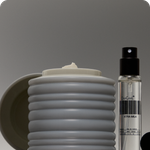Urea

Happy 250th birthday, urea—an ingredient which is sorely misunderstood, though to those who know of its powers, would be sorely missed if by some cruel twist of fate or supply chain disruption, it were to ever disappear. A tiny molecule with huge moisture-retaining and exfoliating benefits, it might be the most under-appreciated skincare ingredient out there. Let's change that. Today, we honor you…ree-uh.
This natural compound is most commonly known for its unglamorous origin story: It was discovered in pee in 1773.1 In the body, the liver converts toxic ammonia into urea, which is then filtered out by the kidneys as urine. Because urea is highly water soluble and absorbent—and because we create a lot of it every day—it concentrates in your pee so you can get rid of large quantities of it without having to use the bathroom constantly.

In skincare, it’s known for being an effective humectant, an ingredient that helps the skin retain moisture. But to answer your next question: No, the urea used in skincare products is not derived from urine, and hasn't been for two centuries. Synthetic urea was first created by chemist Friedrich Wöhler in 1828, a discovery that helped define the field of organic chemistry as we know it. It was the very first organic compound to be synthesized from an inorganic source, meaning no living organisms were required to make it. Wöhler’s ureic legacy was so renowned that his death was commemorated with a German postal stamp featuring the molecular structure of urea—a major upgrade in its relationship with household paper goods.2
Today, urea can be created in a lab with the same compounds it’s made of inside the body. (Interestingly, it’s also used to make fertilizer and melamine plastic, a story for another time…) Aftr centuries of study, urea is completely safe for skin, validated by the US FDA’s research and evaluation of its use in cosmetics.3 In fact, some of its first uses were for wound care because of its antimicrobial properties. Dermatologists, estheticians, chemists, skincare obsessives—we all love the stuff. It's the rest of the world we're trying to get on board.
When urea is filtered through the kidneys, it travels through our bloodstream, and even into skin cells. Like hyaluronic acid, urea is a fundamental part of skin’s NMF (natural moisturizing factor); it helps regulate the skin’s moisture levels. When included in a skincare product, urea boosts its hydrating efficacy.
Urea is also hygroscopic, which means it has a powerful ability not just to moisturize the skin, but to penetrate the skin barrier and hold onto water. It helps keep the skin hydrated over time. Water-attracting materials like hyaluronic acid, glycerin, and aloe vera (which have had more successful PR campaigns than urea) function similarly, attracting moisture and retaining it within skin cells.4

What makes urea unique is that, at certain concentrations, it also exfoliates and softens the skin as a keratolytic agent. Other keratolytic ingredients you might be familiar with are salicylic acid, lactic acid, and glycolic acid. This category of molecules loosen dead skin cells on the outer layer of your epidermis (the stratum corneum), allowing for them to easily be buffed or washed away, leaving a smoother surface. And because urea is a familiar compound in the body, it’s less likely to irritate the skin in the process, making it a reliable exfoliant choice for dry and sensitive skin.5,6
Urea is also a “lipid barrier disruptor,” which means that it penetrates the skin barrier and disrupts the ecosystem there, so to speak, allowing other chemical components to also penetrate. Basically, urea can help other ingredients to activate, such as antifungal drugs in foot creams.7
That said, the quantity of urea in a skincare product changes its function. Some lotions and creams contain a small percentage of urea to enhance their moisturizing and softening ability. Higher percentages increase the exfoliant, or keratolytic, effects.4,5
- 2% — 12% urea improves water retention in skin and loosens dead skin cells.
- 20% — 30% urea significantly improves skin barrier function and reduces tough, callused skin.
- 40% — 50% urea is used for targeted spot treatments (often for feet) to reduce hard calluses, corns, and extra thick, dry, cracked skin.
WE COULDN’T DO IT WITHOUT UREA

Soft Services
Carea Cream
$40
11 fl oz
fragrance-free
A lightweight body lotion with 10% urea that deeply moisturizes and gently exfoliates. This more-than-just-a moisturizer cares for dry and weathered body skin.

Soft Services
Smoothing Solution
$30
3.3 fl oz
fragrance-free
This is a leave-on chemical exfoliant (10% AHA, 5% urea) that dissolves build-up of dead skin cells with soothing ingredients that help calm visible irritation.
References:
1 Sha, M.A., Allen. Urea in Cosmetic Products.
2 Ritter, Stephen. “Chemists Make Urea with a P.” Chemical & Engineering News, 2023. Accessed 9 Feb. 2023.
3 Sadoff, M.S., Scott F. Use and Safety of Urea in Cosmetic Products.
4 Marie, Natalie. “The Fascinating Role of Urea in Skin Care.” LiVDerm, 19 May 2022. Accessed 9 Feb. 2023.
5 Grether-Beck, Susanne, et al. “Urea Uptake Enhances Barrier Function and Antimicrobial Defense in Humans by Regulating Epidermal Gene Expression.” The Journal of Investigative Dermatology, vol. 132, no. 6, 1 June 2012, pp. 1561–1572, https://doi.org/10.1038/jid.2012.42.
6 “Keratolytic Agent - an Overview | ScienceDirect Topics.” www.sciencedirect.com.
7 S. Dars, H. A. Banwell, and L. Matricciani. “The use of urea for the treatment of onychomycosis: a systematic review.” J Foot Ankle Res. April 2019.
Get Updates
There’s more to come.
Sign up to receive periodical updates on Mass Index, and to be the first to know when Soft Services launches new products. (If we don’t have any updates, we won’t email you.)
Body Skin
Your body skin is determined by hundreds of factors unique to each individual.
Learn More: Body Skin






















